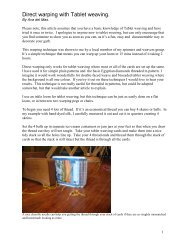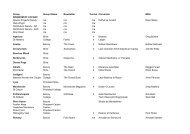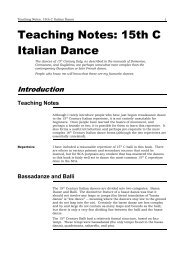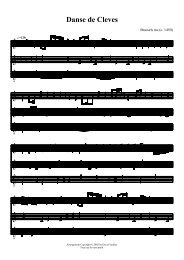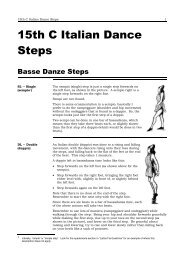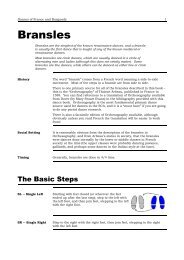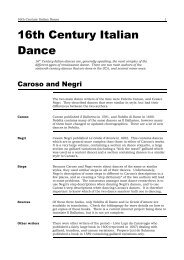15th Century Italian Dance
15th Century Italian Dance
15th Century Italian Dance
You also want an ePaper? Increase the reach of your titles
YUMPU automatically turns print PDFs into web optimized ePapers that Google loves.
<strong>15th</strong> <strong>Century</strong> <strong>Italian</strong> <strong>Dance</strong> 5Contrapasso Contrapassi are doubles that are done consecutively on the same foot .The first double is step left-right-left as a normal doppio, and then do aquick shift of weight onto the right foot.The next contrapasso will also begin on the left foot, so two or morecontrapassi in a row will be done left, left, left, not like sempii or dopiiwhich would be done left, right, left.The last contrapasso in a sequence is abbreviated, so that instead offinishing with a movement back on to the right foot, it simply omits thefinal step onto the left. So, two contrapassi in a row would be done as stepleft, step right, step left & back, step left, step right; still finishing with theleft foot ready to lead the next step. Three of them would be done step left,step right, step left & back, step left, step right, step left & back, step left,step right.Contrapassi can also be done on the right foot, which are the same asdescribed above but changing “left” for “right” throughout.Note that two of these steps are done in 1½ bars of music, and so the lastmovement back onto the left foot is done rather quickly, and the timing ofthe steps must be arranged carefully to match the music.Diana Cruickshank examines this contrapasso step in detail in an articlein Historical <strong>Dance</strong>, 1992.ReprisaThe Ripresa, the <strong>Italian</strong> equivalent of the French Reprise was done quitedifferently. Basically it looks like two singles, and takes 1 measure.RpB -- RipresaBackwardsStep backwards with the right foot, bending the knee slightly. Then joinfeet, stepping backwards with the left foot and rising onto the toes. Thenrepeat the same movements, stepping backwards onto the flat of the rightfoot, and then step backwards with the left foot, rising onto the toes again. 2RpF -- RipresaForwardsThis step can be done forwards on the left or the right foot. It is similar tothe riprese backwards, listed above, but done moving forwards.RpL -- Ripresa LeftStep to the left with the left foot, bending at the knees very sightly andremaining on the flat of the feet. Then join feet, stepping left with the rightfoot, and rising onto the toes. Repeat the movement, stepping with the leftfoot and dipping, and then stepping with the right foot and rising. Thisriprese can also be done with the right foot, moving to the right. 3RpT -- RipresaTurningPlace the left foot in front of the right foot, heel to toe, and bend at theknees. Then, rising on the toes, swivel in place through 180° over theright shoulder. The left foot will now be behind the right foot. Repeat themovement, placing the left foot in front of the right foot while bending atthe knees, then rise and swivel again.2 The riprese in the 16th C <strong>Italian</strong> dances was done as a single movement, in much faster time (half the time of a single continenza),and always done sideways, never backwards or forwards. Many reconstructors have used the 16th C step as a rationale forinsisting that the <strong>15th</strong> C step of the same name was also a single step. I reject this on the basis of the steps in Pietosa -- tworiprese forwards cover the same distance as two doubles (dopii) forwards, and hence fit better if they are two steps. Cornazanoprovides another clue here -- he states that the length of a riprese should be varied, and also makes a statement that could beinterpreted that the step can be done in two movements.3 I make the assumption that the sideways ripresa is done in the same number of movements as the forwards or backwards ripresa.There is possibly less justification for this. The steps should be much smaller than the forwards or backwards riprese (see myprevious comment about Cornazano), especially in dances like La Spagna, Reale, and Pietosa, where the dancers are moving apartwhile holding hands.




